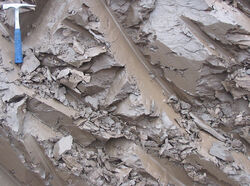| Clay | |
|---|---|
 | |
| Type | Term |
| Essential mineral(s) | {{{Essential mineral(s)}}} |
| Accessory mineral(s) | {{{Accessory mineral(s)}}} |
Clay (not to be confused with clay minerals) to geologists is a rock term indicating that the grain size of the carious minerals comprising the rock is less than 2 µm (micrometre).
Formation[]
Clay minerals are typically formed over long periods of time by the gradual chemical weathering of rocks, usually silicate-bearing, by low concentrations of carbonic acid and other diluted solvents. These solvents, usually acidic, migrate through the weathered rock after leaching through the upper weathered layers. In addition to the weathering process, some clay minerals are formed by hydrothermal activity. Clay deposits may be formed in places as residual deposits in soil, but thick deposits usually are formed as the result of a secondary sedimentary deposition process after they have been eroded and transported from their original location of formation. Clay deposits are typically associated with very low energy depositional environments such as large lakes and marine basins.
Primary clays, also known as kaolins, are located at the site of formation. Secondary clay deposits have been moved by erosion and water from their primary position.
Note:[]
Needs more material and rewording of fomation
References[]
http://dvbwuccgeoclass.blogspot.com/2010/11/difference-between-caly-and-shale.html
The 23RD Edition of The Manual of Mineral Science